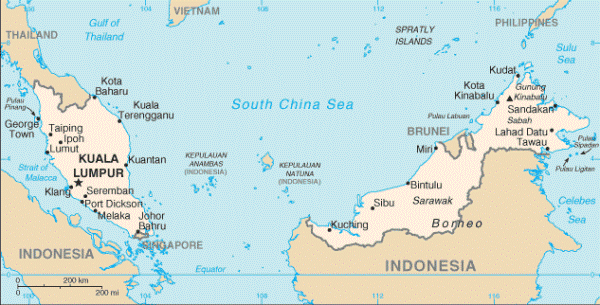Topics Covered
Welcome to Malaysia
Overview of Resources
Industrial Minerals
Metals
Fossil Fuels
Investment
Sources
Welcome to Malaysia
Malaysia with a total population of 29,179,952 as of July 2012 is located in Southeastern Asia. The country has a tropical climate and covers a total area of 329,847 km2.
Malaysia as a country was formed in 1963. From being a producer of raw materials in the past, the country has successfully transformed itself into an emerging multi-sector economy.
 |
The national flag of Malaysia.
Image Credit: CIA Factbook |
The country’s economy once totally depended on the service sector and on the exports of manufactured goods. The government has been trying to increase the country’s domestic demand and thus reduce its dependence on exports.
In 2010, the country’s economy increased to a moderate level due to the slow recovery of the global economy. This economic growth was mainly because of the increasing domestic demand that was mostly from the private sectors. The increase in investments from the public and private sectors resulted in the expansion of capital spending in the mining, service and manufacturing sectors. The country’s GDP as of 2011 was $453 billion.
Overview of Resources
Malaysia’s key natural resources include natural gas, petroleum, copper, tin, bauxite and iron ore. The country’s identified mineral resources other than its key natural resources include monazite, ilmenite, struverite, zircon and silica.
Mineral production contributed a lot to Malaysia’s economy. The production of minerals such as iron ore, barite, copper, bauxite and ilmenite decreased to a major extent in the recent years and some of them have also been depleted.
Investment in the country’s mining sector was chiefly made to carry out the exploration and production activities of oil and natural gas.
Industrial Minerals
In 2011, the production of the key minerals in Malaysia had an estimated value of 6.18 billion ringgit in comparison with the 2010 mineral production that was valued at 3.99 billion ringgit.
The production of gold, iron ore and coal also increased in 2011. The production of iron ore doubled to 7.6 million t, gold production doubled to 4,215 kg and coal output reached 2.9 million t.

The map of Malaysia. Image Credit: CIA Factbook
Metals
Malaysia is one of the chief tin producing countries in the world. Recently, the country experienced a drift in its tin production capacity due to lower ore grades and depleted reserves. In 2010, the production of tin increased by more than 10%.
Aluminum Corporation of China and Gulf International Investment Group Holdings Sdn Bhd planned to develop an aluminum smelter in Samalaju Industrial Park at Bintulu in the State of Sarawak in 2010. Operation of this $1.6 billion smelter will commence in 2015.
Malaysia had about 12 gold mines located in Pahang, Kelantann and Terengganu in 2010. More than 90% of the country’s gold was from The Penjom Gold Mine, in the state of Pahang. More than 1 million oz of gold was produced by gold mines in Raub. Peninsular, a gold producing company in Malaysia, aims at discovering a minimum of 5 million oz of gold in its project areas.
Iron ore in Malaysia is produced from the country’s small-scale mines and the low-grade iron ores are used by the gas and oil sectors and also by the pipe-coating industry.
Fossil Fuels
In 2010, Malaysia’s oil and gas sectors profited from the increasing global energy prices. More than 40% of the government revenue in 2010 was contributed by the country’s oil and gas sectors.
The production of natural gas increased by about 7% to 62.7 billion m3 in 2010. The increasing demand for LNG from Japan and China was the major reason for this. In the same year, the country saw a decrease in its production of crude oil and condensate.
Malaysia has coal resources of about 1.9 billion Mt (Gt) and about 1.5 Gt of the coal resources in the country is located in Sarawak. More that 300 Mt of coal is located in Sabah. Coal in the interior regions of Malaysia had not been exploited in 2010 due to lack of infrastructure.
Investment
Malaysia’s mining industry is all set for a fresh start after a very long period of inactivity due to price manipulation. The total recovery in the tin mining sector is because of an increase in the issuance and renewal of a number of mining leases and also because of foreign and domestic investments.
Recent reports on the mining industry highlight that the government hopes to double its exports of minerals in 2012. To uplift the country’s economic status the government also plans to relax a few rules regarding initial public offerings, foreign investment and the financial sector.
In the coming years, a number of oil and natural gas projects are expected to be developed in Malaysia. Its economic rate is thus projected to grow slowly in the coming years with the government expecting to reduce the country’s dependence on external markets by increasing the production of goods to be exported. Reassessment of government subsidies, privatization of state-owned companies and selling of government land are some of the measures the government hopes to carry out in the future to uplift Malaysia’s economic status.
Disclaimer: The Author of this article does not imply any investment recommendation and some content is speculative in nature. The Author is not affiliated in any way with any companies mentioned and all statistical information is publically available.
Sources
Disclaimer: The views expressed here are those of the author expressed in their private capacity and do not necessarily represent the views of AZoM.com Limited T/A AZoNetwork the owner and operator of this website. This disclaimer forms part of the Terms and conditions of use of this website.